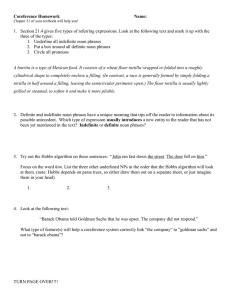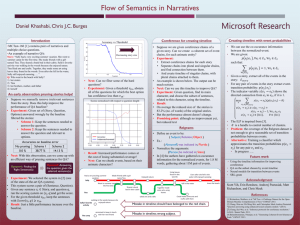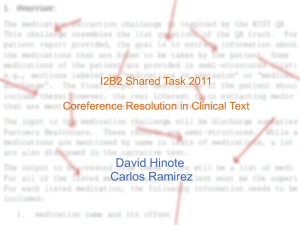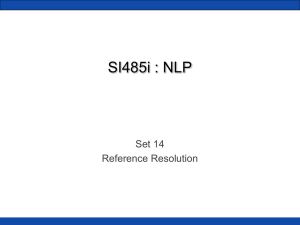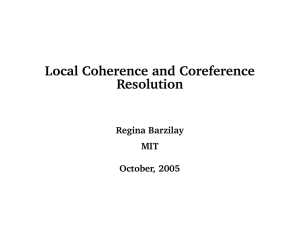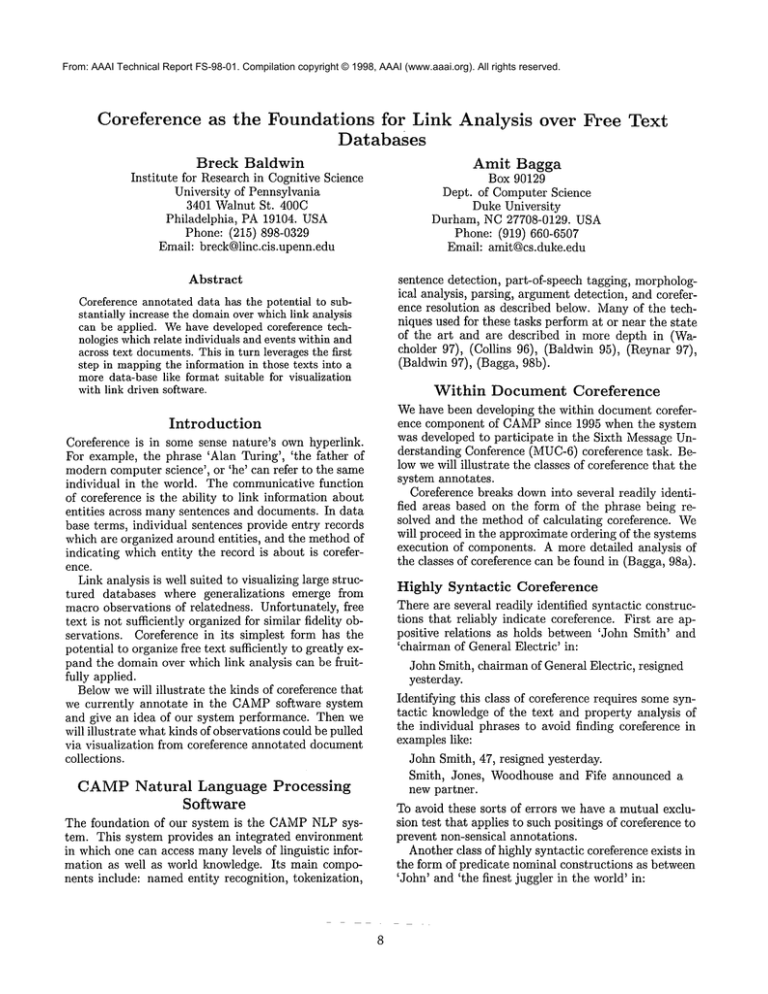
From: AAAI Technical Report FS-98-01. Compilation copyright © 1998, AAAI (www.aaai.org). All rights reserved.
Coreference as the Foundations for Link Analysis
Databases
Breck
Baldwin
for Research in Cognitive Science
University of Pennsylvania
3401 Walnut St. 400C
Philadelphia, PA 19104. USA
Phone: (215) 898-0329
Email: breck@linc.cis.upenn.edu
Amit Bagga
Box 90129
Dept. of Computer Science
Duke University
Durham, NC 27708-0129. USA
Phone: (919) 660-6507
Email: amitQcs.duke.edu
Institute
Abstract
sentence detection, part-of-speech tagging, morphological analysis, parsing, argumentdetection, and coreference resolution as described below. Manyof the techniques used for these tasks perform at or near the state
of the art and are described in more depth in (Wacholder 97), (Collins 96), (Baldwin 95), (Reynar
(Baldwin 97), (Bagga, 98b).
Coreference annotated data has the potential to substantially increase the domainover whichlink analysis
can be applied. V~re have developedcoreference technologies whichrelate individuals and events within and
across text documents.This in turn leverages the first
step in mappingthe information in those texts into a
moredata-base like format suitable for visualization
with link driven software.
Within
Document
Coreference
Wehave been developing the within document coreference component of CAMPsince 1995 when the system
was developed to participate in the Sixth Message Understanding Conference (MUC-6)coreference task. Below we will illustrate the classes of coreference that the
system annotates.
Coreference breaks downinto several readily identified areas based on the form of the phrase being resolved and the method of calculating coreference. We
will proceed in the approximate ordering of the systems
execution of components. A more detailed analysis of
the classes of coreference can be found in (Bagga, 98a).
Introduction
Coreference is in some sense nature’s own hyperlink.
For example, the phrase ’Alan Turing’, ’the father of
modern computer science’, or ’he’ can refer to the same
individual in the world. The communicative function
of coreference is the ability to link information about
entities across many sentences and documents. In data
base terms, individual sentences provide entry records
which are organized around entities, and the method of
indicating which entity the record is about is coreference.
Link analysis is well suited to visualizing large structured databases where generalizations
emerge from
macro observations of relatedness. Unfortunately, free
text is not sufficiently organized for similar fidelity observations. Coreference in its simplest form has the
potential to organize free text sufficiently to greatly expand the domainover which link analysis can be fruitfully applied.
Belowwe will illustrate the kinds of coreference that
we currently annotate in the CAMPsoftware system
and give an idea of our system performance. Then we
will illustrate what kinds of observations could be pulled
via visualization from coreference annotated document
collections.
CAMP Natural
Language
over Free Text
Highly Syntactic
Coreference
There are several readily identified syntactic constructions that reliably indicate coreference. First are appositive relations as holds between ’John Smith’ and
’chairman of General Electric’ in:
John Smith, chairman of General Electric, resigned
yesterday.
Identifying this class of coreference requires some syntactic knowledge of the text and property analysis of
the indixddual phrases to avoid finding coreference in
exampleslike:
John Smith, 47, resigned yesterday.
Smith, Jones, Woodhouse and Fife announced a
new partner.
To avoid these sorts of errors we have a mutual exclusion test that applies to such positings of coreference to
prevent non-sensical annotations.
Anotherclass of highly syntactic coreference exists in
the form of predicate nominal constructions as between
’John’ and ’the finest juggler in the world’ in:
Processing
Software
The foundation of our system is the CAMPNLPsystem. This system provides an integrated environment
in which one can access manylevels of linguistic information as well as world knowledge. Its main components include: named entity recognition, tokenization,
8
John is the finest juggler in the world.
Like the appositive case, mutual exclusion tests are required to prevent incorrect resolutions as in:
John is tall.
They are blue.
These classes of highly syntactic coreference can play
a very important role in bridging phrases that we would
normally be unable to relate. For example, it is unlikely
that our software would be able to relate the same noun
phrases in a text like
The finest juggler in the world visited Philadelphia
this week. John Smith pleased crowds every night
in the Annenberg theater.
This is because we do not have sufficiently sophisticated
knowledgesources to determine that jugglers are very
likely to be in the business of pleasing crowds. But the
recognition of the predicate nominal will allow us to
connect a chain of ’John Smith’, ’Mr. Smith’, ’he’ with
a chain of ’the finest juggler in the world’, ’the juggler’
and ’a juggling expert’.
is that very conservative approaches to exact and partial string matches overgenerate badly. Someexamples
of actual chains are:
¯ his dad’s trophies <- those trophies
¯ those words <- the last words
¯ the risk <- the potential risk
¯ its accident investigation <- the investigation
Wehave adopted a range of matching heuristics and
salience strategies to try and recognize a small, but accurate, subset of these coreferences.
Pronoun Coreference
The pronominal resolution component of the system
is perhaps the most advanced of all the components.
It features a sophisticated salience model designed to
produce high accuracy coreference in highly ambiguous
texts. It is capable of noticing ambiguity in text, and
will fail to resolve pronouns in such circumstances. For
examplethe system will not resolve ’he’ in the following
example:
Earl and Ted were working together when suddenly
he fell into the threshing machine.
Weresolve pronouns like ’they’, ’it’, ’he’, ’hers’,
’themselves’ to proper nouns, commonnouns and other
pronouns. Depending on the genre of data being processed, this component can resolve 60-90% of the pronouns in a text with very high accuracy.
Proper Noun Coreference
Namesof people, places, products and companies are
referred to in manydifferent variations. In journalistic
prose there will be a full nameof an entity, and throughout the rest of the article there will be ellided references
to the same entity. Somename variations are:
¯ Mr. James Dabah <- James <- Jim <- Dabah
¯ Minnesota Mining and Manufacturing <- 3M Corp.
<- 3M
¯ Washington D.C. <- WASHINGTON
<- Washington
<- D.C. <- Wash.
¯ New York <- New York City <- NYC<- N.Y.C.
The Overall Nexus of Coreference
in a
Document
Once all the coreference in a document has been computed, we have a good approximation of which sentences are strongly related to other sentences in the
document by counting the number of coreference links
between the sentences. We know which entities
are
mentioned most often, and what other entities are involved in the same sentences or paragraphs. This sort
of information has been used to generate very effective
summaries of documents and as a foundation for a simple visualization interface to texts.
This class of coreference forms a solid foundation over
which we resolve the remaining coreference in the document. One reason for this is that we learn important
properties about the phrases in virtue of the coreference
resolution.
For example, we may not know whether
’Dabah’ is a person name, male name, female name,
companyor place, but upon resolution with ’Mr. James
Dabah’ we then knowthat it refers to a male person.
Weresolve such coreferences with partial string
matching subroutines coupled with lists of honorifics,
corporate designators and acronyms. A substantial
problem in resolving these names is avoiding overgeneration like relating ’Washington’ the place with the name
’Consuela Washington’. Wecontrol the string matching with a range of salience functions and restrictions
of the kinds of partial string matches we are willing to
tolerate.
Cross
Document
Coreference
Cross-document coreference occurs when the same person, place, event, or concept is discussed in more than
one text source. Figure 1 shows the architecture of the
cross-document module of CAMP.This module takes
as input the coreference chains produced by CAMP’s
within document coreference module. Details about
each of the main steps of the cross-document coreference algorithm are given below.
Common Noun Coreference
A very challenging area of coreference annotation involves coreference between commonnouns like ’a shady
stock deal’ and ’the deal’. Fundamentally the problem
¯ First, for each article, the within document coreference module of CAMPis run on that article.
It
produces coreference chains for all the entities mentioned in the article. For example, consider the two
extracts in Figures 2 and 4. The coreference chains
9
C0rcferenceChainsfor doe.01
PU~i~ttYc°freP~erenr~Yc~l
V~ysi:SkC°~efe rei ce ChainsW7
d°c ’02
)C°~
C
e~eren~
Chains
Cross-DocumentCoreferenee Chains
summary’O1[
I
VSMDisambiguate
~umm
I<
ary.nn[ .~
Figure 1: Architecture of the Cross-Document Coreference System
of interest. These summariesare a special case of the
query sensitive techniques being developed at Penn
using CAMP.Therefore, for doc.36 (Figure 2), since
at least one of the three noun phrases ("John Perry,"
"he," and "Perry") in the coreference chain of interest
appears in each of the three sentences in the extract,
the summary produced by SentenceExtractor is the
extract itself. On the other hand, the summaryproduced by SentenceExtractor for the coreference chain
of interest in doc.38 is only the first sentence of the
extract because the only element of the coreference
chain appears in this sentence.
Finally, for each article, the VSM-Disambiguate
module uses the summaryextracted by the SentenceExtractor and computes its similarity with the summaries extracted from each of the other articles. The
VSM-Disambiguate module uses a standard vector
space model (used widely in information retrieval)
(Salton, 89) to compute the similarities between the
summaries. Summaries having similarity
above a
certain threshold are considered to be regarding the
same entity.
John Perry, of Weston Golf Club, announced
his resignation yesterday. He was the President
of the Massachusetts Golf Association. During his
two yearsin office, Perry guided the MGAintoa
closer relationship with the Women’sGolf Association of Massachusetts.
Figure 2: Extract from doc.36
Figure 3: Coreference Chains for doc.36
output by CAMPfor the two extracts
Figures 3 and 5.
are shown in
¯ Next, for the coreference chain of interest within each
article (for example, the coreference chain that contains "John Perry"), the Sentence Extractor module extracts all the sentences that contain the noun
phrases which form the coreference chain. In other
words, the SentenceExtractor
module produces a
"summary"of the article with respect to the entity
Experiments
and Results
Wetested our cross-document system on two highly
ambiguoustest sets. The first set contained 197 articles
from the 1996 and 1997 editions of the NewYork Times,
while the second set contained 219 articles from the
1997 edition of the NewYork Times. The sole criteria
10
Oliver "Biff" Kelly of Weymouth succeeds
John Perry as president of the Massachusetts Golf
Association. "Wewill have continued grouch in the
future," said Kell3; who will serve for two years.
"There’s been a lot of changes and there w/// be
continued changes as we head into the year 2000."
Precision/Recallvs Threshold
100
90
ur AIg: F-Measure
-E3--
80
~
: ","b
’,,-..
70
~,
o
Figure 4: Extract from doc.38
a.
6o
50
/
a__a.o__D_~_G__~_~
~, ""~-.mQ._a_~_
40I T--[]
3O ~-~
20’
D
"-...
"""+--+--+ - -+_._+___~__~__+_
_+___~___~
~..~
10
I
0
0
i
Figure 5: Coreference Chains for doc.38
I
I
I
I
I
0.1 0.2 0.3 0.4 0.5 0.6
Threshold
I
i
I
0.7 0.8 0.9
Figure 7: Precision, Recall, and F-Measure Using Our
Algorithm for the John Smith Data Set
for including an article in the two sets was the presence
of a string matching the "/John.*?Smith/’, and the
"/resign/" regular expressions respectively.
The goal for the first set was to identify crossdocument coreference chains about the same John
Smith, and the goal for the second set was to identify
cross-document coreference chains about the same "resign" event. The answer keys were manually created,
but the scoring was completely automated.
There were 35 different John Smiths in the first set.
Of these, 24 were involved in chains of size 1. The
other 173 articles were regarding the 11 remaining John
Smiths. Descriptions of a few of the John Smiths are:
Chairman and CEOof General Motors, assistant track
coach at UCLA,the legendary explorer, and the main
character in Disney’s Pocahontas, former president of
the Labor Party of Britain. In the second set, there
were 97 different "resign" events. Of these, 60 were
involved in chains of size 1. The articles were regarding resignations of several different people including
Ted Hobart of ABCCorp., Dick Morris, Speaker Jim
Wright, and the possible resignation of Newt Gingrich.
Precision/Recallvs Threshold
100
OurAlg: Precision-e-"% a/~
OurAIg: Recall -~-".~.’E]--E].~
--’/ "~-. -~-~-".m,.13_OurAIg"¯ F-Measure
-E]-.,re
90
80
¯"
70
~"""~’-~-l%
E)- "3-- E]- *O"* G]-- E]"~-- {3._E]
60
o
g
50
40
30
20
10
0
I
0
i
I
I
I
I
0.1 0.2 0.3 0.4 0.5 0.6
Threshold
I
I
I
0.7 0.8 0.9
Figure 8: Precision, Recall, and F-Measure Using Our
Algorithm for the "resign" Data Set
The final precision and recall numbers are computed
by the following two formulae:
N
Final Precision = E wi * Precisioni
Scoring and Results
In order to score the cross-document coreference chains
output by the system, we had to map the crossdocument coreference scoring problem to a withindocument coreference scoring problem. This was done
by creating a meta document consisting of the file
names of each of the documents that the system was
run on. Assuming that each of the documents in the
two data sets was about a single John Smith, or about
a single "resign" event, the cross-document coreference
chains produced by the system could now be evaluated
by scoring the corresponding within-document coreference chains in the meta document.
Precision and recall are the measures used to evaluate the chains output by the system. For an entity, i,
we define the precision and recall with respect to that
entity in Figure 6.
i=l
N
Final Recall = E wi * Recalli
i=1
where N is the number of entities in the document, and
w~ is the weight assigned to entity i in the document.
For the results discussed in this paper, equal weights
were assigned to each entity in the meta document. In
other words, w~ = 1 for all i. Full details about the
scoring algorithm can be found in (Bagga, 98).
Figure 7 shows the Precision, Recall, and the FMeasure (the average of precision and recall with equal
weights for both) statistics for the John Smith data set.
The best precision and recall achieved by the system on
this data set was 93%and 77% respectively (when the
11
Precisioni -Recalli =
number of correct elements in the output chain containing entity~
number of elements in the output chain containing entityi
number of correct elements in the output chain containing entityi
number of elements in the truth chain containing entityi
Figure 6: Definitions for Precision and Recall for an Entity i
threshold for the vector space model was set to 0.15).
Similarly, Figure 8 shows the same three statistics for
the "resign" data set. The best precision and recall
achieved by the system on this data set was 94% and
81%respectively. This occurs when the threshold for
the vector space model was set to 0.2. The results show
that the system was very successful in resolving crossdocument coreference.
Possible Generalizations About Large
Data Collections
Derived From
Coreference Annotations
Crucial to the entire process of visualizing large document collections is relating the same individual or event
across multiple documents. This single aspect of our
systemestablishes its viability for large collection analysis. It allows the drops of information held in each
document to be merged into a larger pool that is well
organized.
The Primary Display of Information
Twodisplay techniques immediately suggest themselves
for accessing the coreference annotations in a document
collection, the first is to take the identified entities as
atomic and link them to other entities which co-occur
in the same document. This might reveal a relation between individuals and events, or individuals and other
individuals. For example, such a linking might indicate
that no newspaper article ever mentioned both Clark
Kent and Superman in the same article, but that most
all other famous individuals tended to overlap in some
article or another. On the positive case, individuals,
over time, may tend to congregate in media stories or
events may tend to be more tightly linked than otherwise expected.
The second technique would be to take as atomic the
documents and relate via links other documents that
contain mention of the same entity. With a temporal
dimension, the role of individuals and events could be
assessed as time movedforward.
Finer Grained Analysis
of the Documents
The fact that two entities coexisted in the same sentence
in a document is noteworthy for correlational analysis. Links could be restricted to those between entities
that co-existed in the same sentence or paragraph. Additional filterings are possible with constraints on the
sorts of verbs that exist in the sentence.
12
A more sophisticated version of the above is to access the argument structure of the document. CAMP
software provides a limited predicate argument structure that allows subjects/verbs/objects
to be identified. This ability moves our annotation closer to the
fixed record data structure of a traditional data base.
One could select an event and its object, for instance
’X sold arms to Iraq’ and see what the fillers for X were
in a link analysis. There are limitations to predicate
argument structure matching-for instance getting the
correct pattern for all the selling of arms variations is
quite difficult.
In any case, there appear to be a myriad of applications for link analysis in the domainof large text data
bases.
Conclusions
The goal of this paper has been to articulate a novel
input class for link based visualization techniquescoreference. Wefeel that there is tremendous potential
for collaboration between researchers in visualization
and in coreference annotation given the new space of
information provided by coreference analysis.
Acknowledgments
The second author was supported in part by a Fellowship from IBMCorporation, and in part by the University of Pennsylvania. Part of this work was done
when the second author was visiting the Institute for
Research in Cognitive Science at the University of Pennsyh,ania.
References
Bagga, Amit, and Breck Baldwin. Algorithms for Scoring Coreference Chains. Proceedings of the the Linguistic Coreference Workshop at The First International Conference on Language Resources and Evaluation, May1998.
Bagga, Amit. Evaluation of Coreferences and Coreference Resolution Systems. Proceedings of the First Language Resource and Evaluation Conference, pp. 563566, May 1998.
Bagga, Amit, and Breck Baldwin. Entity-Based CrossDocument Coreferencing Using the Vector Space
Model. To appear at the 17th International Conference on Computational Linguistics and the 36th Annual Meeting of the Association for Computational
Linguistics (COLING-ACL’98),August 1998.
Baldwin, Breck. CogNIAC: A Discourse Processing
Engine. University of Pennsylvania Department of
Computer and Information Sciences Ph.D. Thesis,
1995.
Baldwin, B., C. Doran, J. Reynar, M. Niv, and
M. Wasson. EAGLE:An Extensible Architecture for
General Linguistic Engineering. Proceedings RIAO,
Computer-Assisted Information Searching on Internet, Montreal, Canada, 1997.
Collins, Michael. A NewStatistical
Parser Based on
Bigram Lexical Dependencies. Proceedings of the th
34
Meeting of the Association for Computational Linguistics, 1996.
Ratnaparkhi, Adwait. A MaximumEntropy Model for
Part-Of-Speech Tagging. Proceedings of the Conference on Empirical Methods in Natural Language Processing, pp. 133-142, May1996.
Wacholder, Nina, Yael Ravin, and Misook Choi. Disambiguation of Proper Names in Text. Proceedings
of the Fifth Conference on Applied Natural Language
Processing, pp. 202-208, 1997.
Reynar, Jeffrey, and Adwait Ratnaparkhi. A Maximum Entropy Approach to Identifying
Sentence
Boundaries. Proceedings of the Fifth Conference on
Applied Natural LanguageProcessing, pp. 16-19, 1997.
Salton, Gerard. Automatic Text Processing: The
Transformation, Analysis, and Retrieval of Information by Computer, 1989, Reading, MA: AddisonWesley.
13

